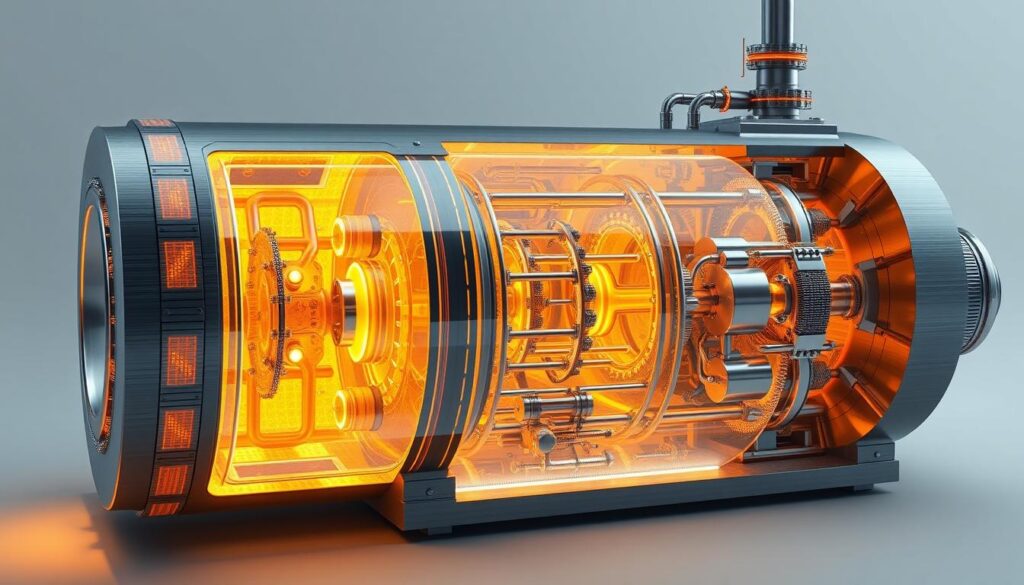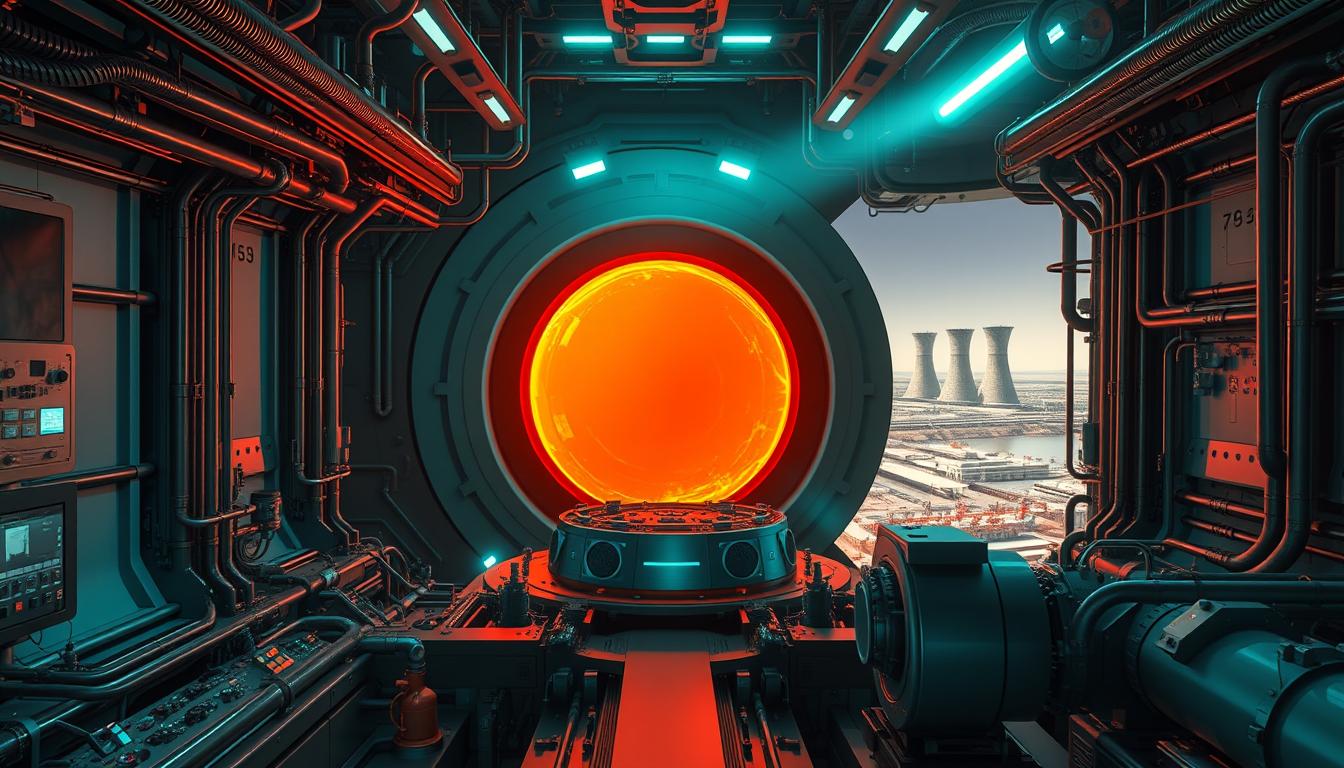The world is on the cusp of a clean energy revolution, and thorium molten salt reactors are at the forefront of this change. As the global demand for energy continues to rise, the need for a sustainable, efficient, and safe source of power has become increasingly pressing. Traditional nuclear power has its drawbacks, but thorium molten salt reactors offer a promising alternative.
This innovative technology harnesses the power of nuclear energy without the associated risks and environmental concerns. With the potential to provide clean energy on a large scale, thorium molten salt reactors are gaining attention worldwide. As we explore the future of nuclear power, it’s essential to understand the benefits and challenges of this emerging technology.
Key Takeaways
- Thorium molten salt reactors offer a safer alternative to traditional nuclear power.
- They have the potential to provide clean energy on a large scale.
- This technology is gaining global attention for its innovative approach.
- Thorium molten salt reactors could play a crucial role in addressing the global energy challenge.
- They represent a significant step forward in nuclear power technology.
The Global Energy Challenge
The world is on the cusp of an energy crisis, driven by burgeoning demands and dwindling traditional resources. As we navigate the complexities of the global energy landscape, it’s clear that our current trajectory is unsustainable.
Growing Energy Demands in the 21st Century
The 21st century has seen a significant surge in global energy demands, driven by industrialization, technological advancements, and population growth. This increased demand puts a strain on existing energy infrastructure.
Environmental Impacts of Conventional Energy Sources
Conventional energy sources, primarily fossil fuels, have severe environmental impacts, including air pollution, water contamination, and greenhouse gas emissions contributing to climate change.
The Need for Clean, Reliable Alternatives
There’s a pressing need for clean energy alternatives that can meet growing demands without exacerbating environmental issues. Thorium Molten Salt Reactors offer a promising solution.
Understanding Thorium as a Nuclear Fuel
In the quest for safer and more efficient nuclear energy, thorium is being explored as a potential game-changer. Thorium, a naturally occurring radioactive element, has been gaining attention for its potential to offer a cleaner, safer, and more sustainable alternative to traditional nuclear fuels.
What is Thorium and Where is it Found?
Thorium is a slightly radioactive metal that is found in small amounts in the Earth’s crust. It is about three to four times more abundant than uranium, the current primary fuel for nuclear reactors.
Chemical and Nuclear Properties
Thorium has several key nuclear properties that make it an attractive fuel. When irradiated, thorium-232 transmutes into uranium-233, a fissile isotope that can sustain a nuclear chain reaction. Thorium also has a higher melting point and is more abundant than uranium.
Global Reserves and Accessibility
Significant thorium reserves are found in various parts of the world, including Australia, the United States, India, and Brazil. According to the World Nuclear Association, thorium resources are estimated to be around 6.4 million tons, although the exact figures can vary based on the source and economic viability.
Advantages Over Uranium
Thorium offers several advantages over uranium, making it an attractive alternative for nuclear energy production.
Proliferation Resistance
One of the significant benefits of thorium is its proliferation resistance. The thorium fuel cycle produces less plutonium and other actinides compared to the uranium fuel cycle, reducing the risk of nuclear material being diverted for weapons production.
Waste Profile Comparison
The waste produced by thorium reactors has a shorter half-life compared to that from uranium reactors. This means that the nuclear waste from thorium reactors becomes less radioactive much faster, reducing the long-term storage challenges.
| Characteristics | Thorium | Uranium |
|---|---|---|
| Abundance | More abundant | Less abundant |
| Proliferation Resistance | Higher | Lower |
| Waste Half-life | Shorter | Longer |
As the world continues to explore cleaner and more sustainable energy sources, understanding thorium’s potential as a nuclear fuel is crucial. Its advantages in terms of abundance, proliferation resistance, and waste profile make it an attractive option for future nuclear energy production.
The History of Thorium Molten Salt Reactor Technology
The history of thorium molten salt reactor technology is marked by early promise, followed by a period of dormancy, and now a resurgence in interest. This technology has its roots in research conducted at Oak Ridge National Laboratory.
Early Research at Oak Ridge National Laboratory
In the 1950s and 1960s, scientists at Oak Ridge National Laboratory began exploring the potential of thorium as a nuclear fuel. Their research focused on the use of molten salt as both a fuel carrier and a coolant, which offered several potential advantages over traditional nuclear reactor designs.
The Molten-Salt Reactor Experiment (1965-1969)
The Molten-Salt Reactor Experiment was a pivotal moment in the development of thorium molten salt reactor technology. Conducted from 1965 to 1969, this experiment demonstrated the feasibility of using molten salt as a fuel matrix and coolant. The success of this experiment was a significant milestone, showcasing the potential for thorium molten salt reactors to be efficient and safe.
Why Development Stalled During the Cold War
Despite the promising results from the Molten-Salt Reactor Experiment, development of thorium molten salt reactor technology slowed significantly during the Cold War. The focus shifted towards more conventional nuclear reactor designs, which were perceived as more established and less risky.
Renewed Interest in the 21st Century
In recent years, there has been a renewed interest in thorium molten salt reactor technology due to its potential for clean, efficient, and safe energy production. Countries around the world are now investing in research and development to bring this technology to the forefront of nuclear energy production.
| Period | Event | Significance |
|---|---|---|
| 1950s-1960s | Research at Oak Ridge National Laboratory | Exploration of thorium as a nuclear fuel |
| 1965-1969 | Molten-Salt Reactor Experiment | Demonstrated feasibility of molten salt reactors |
| Cold War Era | Development stalled | Focus shifted to conventional nuclear reactors |
| 21st Century | Renewed interest | Potential for clean, efficient energy production |
How Thorium Molten Salt Reactors Work
Understanding how Thorium Molten Salt Reactors work is crucial to appreciating their potential in the future of clean energy. These reactors leverage the unique properties of thorium and molten salt to offer a safer, more efficient alternative to traditional nuclear power.
Basic Design Principles
The design of Thorium Molten Salt Reactors is centered around the use of molten salt as both the fuel carrier and the coolant. This design choice eliminates the need for solid fuel rods and allows for a more straightforward, efficient heat transfer mechanism.
Core Configuration
The core of a Thorium Molten Salt Reactor is typically configured to maximize the efficiency of the fuel cycle. This involves arranging the molten salt in a way that optimizes neutron economy and heat transfer.
Salt Composition Options
The composition of the molten salt can vary, but it often includes a mixture of thorium and other salts such as lithium fluoride or beryllium fluoride. The choice of salt composition affects the reactor’s performance and safety characteristics.
The Thorium Fuel Cycle Explained
The thorium fuel cycle involves the irradiation of thorium-232 to produce uranium-233, which is then used as fuel. This cycle offers several advantages over traditional uranium-based fuel cycles, including lower waste production and the potential for breeding more fuel than it consumes.
Liquid Fuel Advantages Over Solid Fuel
The use of liquid fuel in Thorium Molten Salt Reactors offers several advantages over traditional solid fuel reactors. These include improved heat transfer, reduced risk of meltdown, and the ability to continuously process and remove fission products.
Heat Transfer and Power Generation
Heat transfer in Thorium Molten Salt Reactors is achieved through the circulation of the molten salt between the reactor core and a heat exchanger. This heat is then used to generate power through a conventional steam turbine or other power conversion system.
| Feature | Thorium Molten Salt Reactors | Traditional Nuclear Reactors |
|---|---|---|
| Fuel Type | Liquid (Molten Salt) | Solid (Uranium Rods) |
| Coolant | Molten Salt | Water or Gas |
| Fuel Cycle | Thorium Fuel Cycle | Uranium Fuel Cycle |

Safety Features of Thorium Molten Salt Reactors
One of the most compelling advantages of TMSRs is their enhanced safety profile, which addresses many concerns associated with conventional nuclear power plants. The safety features of TMSRs are multifaceted, including both inherent and passive safety systems that work together to prevent accidents and minimize risk.
Inherent and Passive Safety Systems
TMSRs are designed with safety in mind, leveraging inherent and passive systems to ensure safe operation. These systems do not require external power or intervention to function.
Freeze Plugs and Drain Tanks
One of the key safety features is the use of freeze plugs and drain tanks. In the event of an emergency, the molten salt fuel can be drained into the tanks, where it solidifies, preventing any potential release of radioactive materials.
Negative Temperature Coefficients
TMSRs also benefit from negative temperature coefficients, meaning that as the temperature increases, the reaction rate decreases. This inherent feedback mechanism helps to stabilize the reactor and prevent overheating.
Low Pressure Operation Benefits
Operating at low pressure is another significant safety advantage of TMSRs. Unlike traditional pressurized water reactors, TMSRs do not require a robust containment structure to withstand high pressures, reducing the risk of catastrophic failure.
Meltdown Resistance and Containment
The design of TMSRs inherently resists meltdown. The fuel is already in a molten state, eliminating the risk of a solid fuel meltdown. Additionally, the containment structure is designed to handle any potential release of radioactive materials.
Comparison with Traditional Nuclear Plants
Compared to traditional nuclear plants, TMSRs offer significant safety advantages. Their inherent and passive safety systems, low-pressure operation, and meltdown resistance make them a safer choice for nuclear energy production.
Environmental Benefits of Thorium Molten Salt Reactors
As the world seeks cleaner energy sources, Thorium Molten Salt Reactors stand out for their significant environmental advantages. These reactors offer a promising solution to the environmental challenges associated with traditional nuclear energy and fossil fuels.
Reduced Nuclear Waste Production
One of the most significant environmental benefits of Thorium Molten Salt Reactors is their ability to produce less nuclear waste compared to conventional nuclear reactors.
Volume Reduction
The volume of nuclear waste generated by Thorium Molten Salt Reactors is significantly less than that produced by traditional nuclear reactors. This reduction is due to the more efficient use of fuel in the thorium cycle.
Shorter-Lived Waste Products
Not only is the volume of waste reduced, but the waste products also have shorter half-lives, making them less hazardous over time. This characteristic greatly reduces the long-term environmental impact.
Lower Carbon Footprint Across Lifecycle
Thorium Molten Salt Reactors have a lower carbon footprint across their lifecycle compared to fossil fuel-based energy sources. The entire process, from construction to operation and decommissioning, is designed to minimize environmental impact.
Resource Efficiency and Land Use
These reactors are designed to be resource-efficient, requiring less land and material resources compared to traditional nuclear or fossil fuel-based power plants. This efficiency contributes to a lower overall environmental footprint.
Water Conservation Advantages
Thorium Molten Salt Reactors can operate at higher temperatures, which allows for more efficient heat transfer and potentially less water usage for cooling, especially when advanced cooling systems are employed. This aspect is particularly beneficial in water-scarce regions.
Current Thorium Molten Salt Reactor Development Projects
Countries around the globe are actively pursuing Thorium Molten Salt Reactor technology, recognizing its potential to revolutionize the nuclear energy landscape. This surge in development is driven by the need for cleaner, more efficient, and safer nuclear energy solutions.
China’s TMSR Program and SINAP
China is at the forefront of TMSR development through its Thorium Molten Salt Reactor (TMSR) program, led by the Shanghai Institute of Applied Physics (SINAP). This initiative has seen significant advancements in reactor design and fuel cycle technology. China’s commitment to TMSR development is a testament to the country’s focus on future energy solutions.
American Startups and Research Initiatives
In the United States, several startups and research institutions are driving TMSR innovation. Key players include:
- TerraPower, known for its advanced reactor designs and fuel cycle technologies.
- Flibe Energy, focusing on the development of liquid fluoride thorium reactors.
Additionally, various university research programs are contributing to the body of knowledge on TMSRs, exploring new materials, designs, and operational efficiencies.
TerraPower and Flibe Energy
TerraPower and Flibe Energy are pioneering companies in the TMSR space. TerraPower is working on advanced reactor technologies that promise enhanced safety and efficiency, while Flibe Energy is developing a liquid fluoride thorium reactor that could offer significant advantages over traditional nuclear reactors.
European and Indian Development Efforts
Europe and India are also actively involved in TMSR development. European research institutions are collaborating on advanced reactor designs, while India is pursuing thorium-based nuclear energy as part of its long-term energy strategy.
International Collaboration Opportunities
The global nature of TMSR development presents numerous opportunities for international collaboration. By sharing knowledge, resources, and expertise, countries can accelerate the development and deployment of TMSRs, ultimately benefiting from this promising technology.
Technical and Regulatory Challenges
Despite the promising future of thorium molten salt reactors, several technical and regulatory challenges must be addressed. The development of these reactors is a complex task that requires overcoming various obstacles.
Materials Science Hurdles
One of the significant technical challenges is related to materials science. The extreme conditions within a thorium molten salt reactor demand materials that can withstand high temperatures and corrosive environments.
Corrosion-Resistant Materials
The need for corrosion-resistant materials is paramount. The molten salt used in these reactors can be highly corrosive, requiring advanced materials that can maintain their integrity over long periods.
Radiation Damage Concerns
Another concern is the impact of radiation damage on the reactor’s structural materials. Radiation can cause materials to degrade, affecting their mechanical properties and potentially leading to reactor failure.
Regulatory Framework Issues in the US
The regulatory framework for thorium molten salt reactors in the US is still in its early stages. Existing nuclear regulations are primarily designed for traditional nuclear reactors, and adapting them to new technologies poses a challenge.
Public Perception and Education Barriers
Public perception and education are crucial for the adoption of thorium molten salt reactors. There is a need to educate the public about the benefits and safety of these reactors to overcome skepticism and misinformation.
Fuel Processing Technology Gaps
Finally, there are gaps in fuel processing technology that need to be addressed. Efficient and safe methods for processing thorium fuel are essential for the commercial viability of thorium molten salt reactors.
| Challenge | Description | Impact |
|---|---|---|
| Materials Science | Corrosion and radiation resistance | Reactor durability and safety |
| Regulatory Framework | Adapting existing regulations | Licensing and compliance |
| Public Perception | Education and awareness | Public acceptance |
| Fuel Processing | Efficient and safe processing methods | Commercial viability |

Economic Considerations for Thorium Energy
The economic viability of thorium energy is gaining attention as a potential game-changer in the global energy landscape. As the world grapples with the challenges of climate change and energy security, thorium molten salt reactors offer a promising alternative to traditional nuclear and fossil fuel-based power generation.
Construction and Operating Cost Projections
One of the key economic advantages of thorium molten salt reactors is their potential for lower construction and operating costs compared to traditional nuclear reactors. According to a study by the Energy Innovation Reform Project, the overnight capital cost for a thorium molten salt reactor could be significantly lower than that of a conventional nuclear power plant.
| Cost Component | Thorium MSR | Conventional Nuclear |
|---|---|---|
| Overnight Capital Cost | $4,500/kW | $6,500/kW |
| Operating and Maintenance Costs | $30/kW-year | $45/kW-year |
| Fuel Costs | $6/MWh | $10/MWh |
As noted by Dr. Kirk Sorensen, a leading expert on thorium energy, “The cost savings come from the simplified design, lower pressure operation, and the ability to build smaller, modular reactors.”
Fuel Cycle Economics
The fuel cycle economics of thorium molten salt reactors are also more favorable compared to traditional uranium-fueled reactors. The abundance of thorium and the efficiency of the fuel cycle contribute to lower fuel costs.
“Thorium is four times more abundant than uranium, making it a virtually unlimited energy source.” –
World Nuclear Association
Comparison with Renewable and Fossil Energy Sources
When comparing thorium energy with renewable and fossil energy sources, it’s essential to consider the levelized cost of electricity (LCOE). According to the International Energy Agency, the LCOE for thorium molten salt reactors could be competitive with solar and wind energy, especially when factoring in the reliability and baseload capability of nuclear power.
Potential for Cost Reduction Through Standardization
Standardization is key to reducing costs in the nuclear industry. By standardizing designs and manufacturing processes, the construction and operating costs of thorium molten salt reactors can be further reduced, making them more competitive in the energy market.
In conclusion, the economic considerations for thorium energy are promising, with potential cost savings in construction, operation, and fuel cycle economics. As the industry moves towards standardization and deployment, thorium molten salt reactors could become a significant player in the global energy mix.
The Potential Impact on America’s Energy Future
Harnessing thorium energy could be the key to unlocking a more sustainable and independent energy future for the United States. With its abundance and potential to provide clean, reliable power, thorium energy is poised to play a significant role in shaping America’s energy landscape.
Path to Energy Independence
Thorium Molten Salt Reactors can significantly reduce America’s dependence on foreign energy sources. By leveraging domestic thorium reserves, the U.S. can enhance its energy security and reduce the impact of global energy market fluctuations.
Job Creation and Economic Growth Opportunities
The development and deployment of thorium energy technology can create new job opportunities in manufacturing, construction, and research. According to a report by the Nuclear Energy Institute, the nuclear industry already supports over 100,000 jobs in the U.S. The growth of the thorium energy sector can further boost economic activity in regions where these projects are developed.
Grid Stability and Baseload Power Reliability
Thorium Molten Salt Reactors can provide baseload power, ensuring grid stability and reliability. This is crucial for supporting the increasing demand for electricity and integrating intermittent renewable energy sources into the grid.
Complementing Renewable Energy Sources
Thorium energy can complement renewable energy sources by providing a reliable, clean power generation option. This can help mitigate the intermittency issues associated with solar and wind power, ensuring a stable energy supply.
In conclusion, thorium energy has the potential to significantly impact America’s energy future by promoting energy independence, driving economic growth, and ensuring grid stability.
Conclusion: The Promise of Thorium Energy
The world is on the cusp of a significant shift in its energy landscape, driven by the need for clean, reliable, and sustainable power. Thorium molten salt reactors have emerged as a promising solution, offering a potential game-changer in the quest for a cleaner energy future.
The thorium energy promise is rooted in its abundance, reduced nuclear waste production, and inherent safety features. As development projects continue to advance, the prospect of commercializing thorium molten salt reactors draws closer, bringing with it the potential to transform the global energy mix.
By harnessing the thorium energy promise, we can move closer to a clean energy future, reducing our reliance on fossil fuels and mitigating the environmental impacts associated with conventional energy sources. As research and development efforts continue to overcome technical and regulatory challenges, the future of thorium energy looks increasingly bright.
With its potential to provide baseload power, complement renewable energy sources, and support energy independence, thorium molten salt reactors are poised to play a significant role in shaping the world’s clean energy future.
FAQ
What is a thorium molten salt reactor?
A thorium molten salt reactor is a type of nuclear reactor that uses thorium as fuel and molten salt as a coolant, offering a potentially safer and more efficient alternative to traditional nuclear reactors.
How does a thorium molten salt reactor work?
A thorium molten salt reactor works by dissolving thorium in a molten salt coolant, which is then circulated through a reactor core, where the thorium undergoes a nuclear reaction, producing heat that is used to generate electricity.
What are the benefits of thorium molten salt reactors?
The benefits of thorium molten salt reactors include improved safety, reduced nuclear waste production, lower operating costs, and the potential for energy independence.
Are thorium molten salt reactors being developed anywhere?
Yes, thorium molten salt reactor development projects are underway in several countries, including China, the United States, and India, with companies like TerraPower and Flibe Energy leading the way.
What are the challenges facing thorium molten salt reactor development?
The challenges facing thorium molten salt reactor development include materials science hurdles, regulatory framework issues, public perception and education barriers, and fuel processing technology gaps.
How do thorium molten salt reactors compare to traditional nuclear reactors?
Thorium molten salt reactors offer several advantages over traditional nuclear reactors, including improved safety, reduced nuclear waste production, and lower operating costs.
Can thorium molten salt reactors be used for both power generation and other applications?
Yes, thorium molten salt reactors can be used for both power generation and other applications, such as hydrogen production, desalination, and industrial process heat.
What is the current status of thorium molten salt reactor technology?
Thorium molten salt reactor technology is currently in the development stage, with several countries and companies working on commercializing the technology.
How do thorium molten salt reactors contribute to energy independence?
Thorium molten salt reactors can contribute to energy independence by providing a domestic source of clean energy, reducing reliance on foreign energy sources, and promoting energy self-sufficiency.
What is the role of thorium in the energy mix of the future?
Thorium has the potential to play a significant role in the energy mix of the future, offering a clean, reliable, and sustainable source of energy that can complement renewable energy sources and reduce greenhouse gas emissions.




